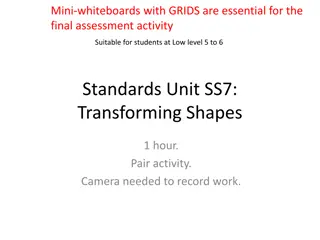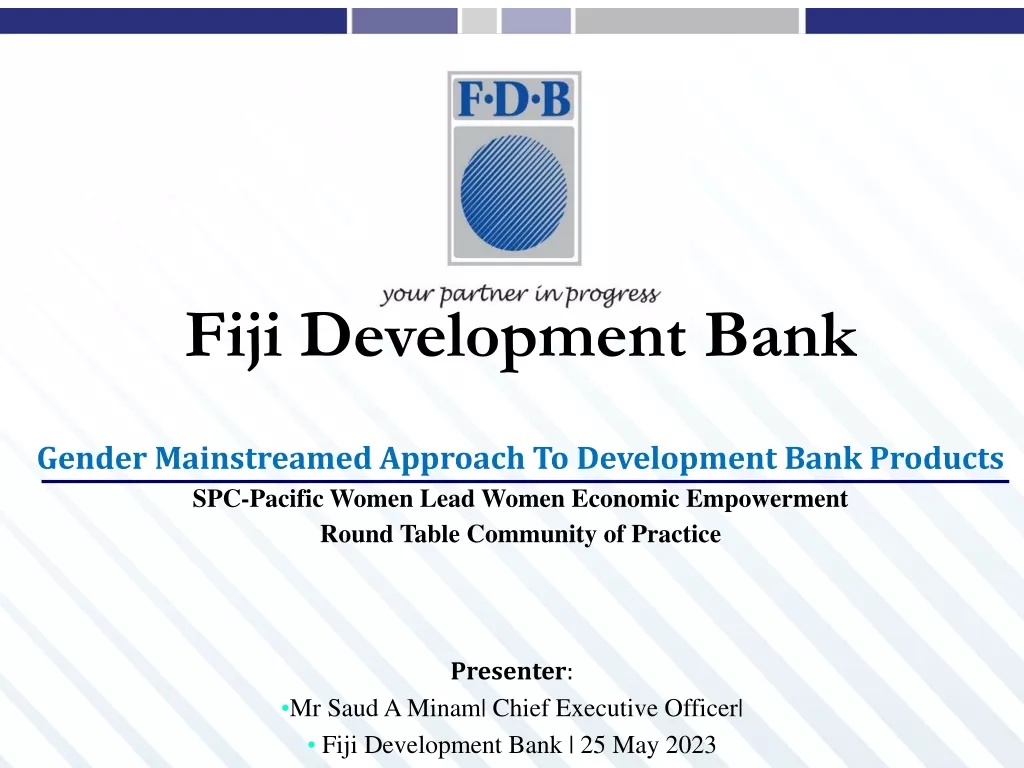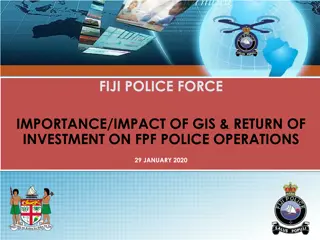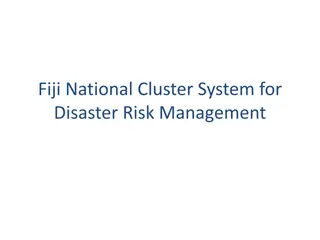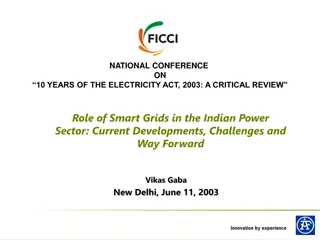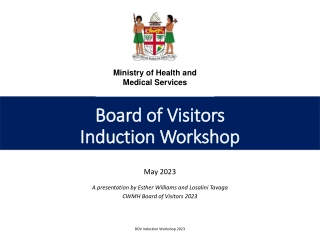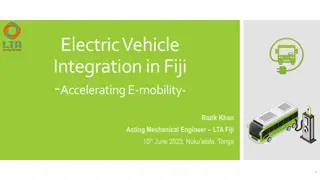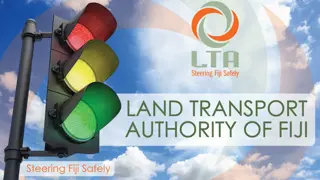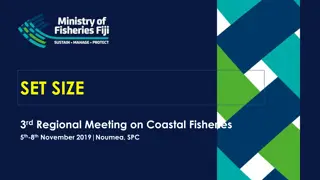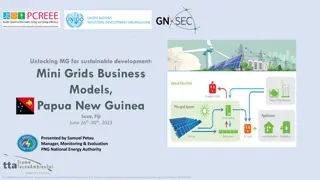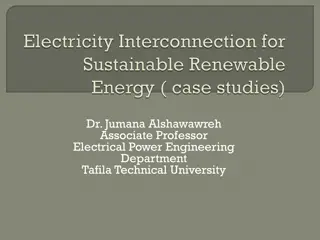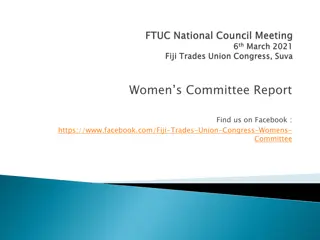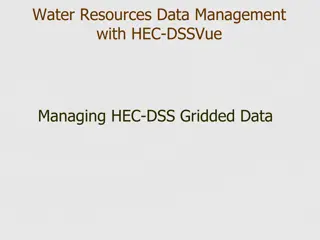Sustainable Development through Mini-Grids in Fiji
Explore the role of mini-grids in Fiji's sustainable development, focusing on electricity access, generation mix, and current mini-grid systems. Learn about the potential of mini-grids to provide clean and reliable energy to rural areas, contributing to climate targets and economic growth.
Download Presentation

Please find below an Image/Link to download the presentation.
The content on the website is provided AS IS for your information and personal use only. It may not be sold, licensed, or shared on other websites without obtaining consent from the author. Download presentation by click this link. If you encounter any issues during the download, it is possible that the publisher has removed the file from their server.
E N D
Presentation Transcript
UNLOCKING MIN-GRIDS FOR SUSTAINABLE DEVELOPMENT FIJI Presenters; Davend Chetty Jonacani Veiqati
TABLE of CONTENT Generation Mix Electricity Status Role of Mini-Grids Current Mini grids Existing Systems Management/Institutional structure for rural electrification and mini-grids Business models/tariff settings for mini-grids Experience and challenges with mini-grids systems Lesson Learnt
GENERATION MIX POWER GENERATION MIX 2020 s power-generation mix was 57.30% hydro, 35.84% industrial diesel oil and heavy fuel oil and 0.12% wind. The remaining 6.87% was provided by the Independent Power Producers (IPPs), namely Tropik Wood Industries Limited (TWIL), Fiji Sugar Corporation (FSC) and Nabou Green Energy Ltd.
Current Electricity Access and Electrification and Climate targets Households in VitiLevu yet to be Electrified Fiji s access to electricity was reported as 96% in a Census of Fiji s population conducted in 2017. This was an increase in access from 89% in 2007. As of now, it stands at 96.2%. Access to electricity was assisted by the Fiji Government s programme to extend the National Grid to rural areas as well assisting rural communities in off grid electricity systems. The services being rendered, is done in a way that we align our work to the SDG 7 target, which is; Households in VanuaLevu yet to be Electrified 100% access to some form of electricity (SDG 7.1) 100% renewable electricity supply by 2036 (SDG 7.2) Strengthen Government Community partnerships in developing rural and maritime infrastructure and accessibility to entice economic growth
Role of Mini-grids Mini-grids have the potential to reliably serve small enterprises in rural areas that rely heavily on diesel, and do not have access to adequate, high-quality electricity. They reduce emissions by providing users, with clean source of energy which is reliable. Under the Department of Energy in Fiji, Mini-grid technologies include, hydropower systems, and solar photovoltaic (PV) modules.
Current Mini-grids systems ( sites, capacity & technologies) on the ground and planned systems. Solar Mini-Grids SITE Tukavesi Solevu Yasawa Lakeba Kadavu Namara, Kadavu Rotuma Nakoro Lautoka LOCATION Tukavesi Vill, Cakaudrove Solevu High School, Yasawa School, Naviti, Yasawa Tubou Village, Lakeba, Lau Vunisea, Kadavu Namara Vill, Sanima, Kadavu Ahau, Rotuma Nakoro Vill, Naikoro, Navosa Vio CAPACITY 60kW 30kW 30kW 153kW 225kW 30kW 153kW 50kW 30kW 1 2 3 4 5 6 7 8 9
Hydro Mini-grids SITE ISLAND CAPACITY 1 Bukuya Viti Levu 100kW 2 Kadavu Koro Kadavu 20kW 3 Muana Vanua Levu 30kW 4 Buca Vanua Levu 30kW
Management/Institutional structure for rural electrification and mini-grids Rural Electrification Managerial Structure; Electrification is set up in the community, and they are encouraged to have represents, women, youth and those living with special needs. members that Committees are trained to be the conduct minor operation and maintenance, and main contact point with the Department. The above structure is for both that are assisted with government diesel generators and Solar Home System. Mini-grids Managerial Structure; Villages to form power committee. They are responsible for the basic management of the system. Normal operation, handling of revenue. Recent change to management committee, is the inclusion of women, for better management of the committee.
Business models/tariff settings for mini-grids IPP model (Private company model) Cooperative model (Community Committee model) Community agreed on the tariff, in consultation with Department of Energy Tariff is agreed by IPP and Department of Energy with consideration on; Example: Bukuya mini hydro Project; Pre-paid system. Payback period(to recognize the investment costs of the system). Communities ability of paying for the said tariff. Cooperative was registered to manage the Bukuya mini hydro, then the Department of Energy, later signed an Agreement with Bukuya mini hydro Cooperative for assistance under Rural Electrification Programme.
Managerial issue. Example with Bukuya Mini Hydro Project. Cooperative constrains, that lead to upgrading and maintenance work being brought to a haul. DOE, then stepped in and cover the cost of upgrade. Later, DOE engaged UNDP (FREPP), to formulate a way forward for the sustainability of Bukuya Mini Hydro Project. Educating public on proper utilization of the system. Basic business skills on proper business practice, since we ourselves are not business experts, we tend to assume that the committee will somehow find a way to make it work in that community. Tariff s main challenge Consumer s ability to pay Development partners coming with their own model but less consideration of local context is taken into account. Consumer s willingness to pay Cover O&M costs (OPEX) Tariff should aim to: Attract private parties to invest in MGs Make MGs financially viable and sustainable Pursue to support economic development and improve living standard in the villages Enable understanding of mini-grid operation Balance sustainability vs Affordability Cover capital cost (CAPEX)
Brief of local models, pros and cons Model Advantages Disadvantages Community Sense of ownership and responsibilities is on them(becoz of sustainability of the project). Communities may lack technical and business stills Governance of the system may not be well managed RE company Responsibility lies with experienced organization Their scale means that they may have better access to spare parts and maintenance Market driven Note: Ideas shared in the table is based on personal opinion
Lesson Learnt Need for feasibility studies to be thoroughly carried out, factoring in; Technical Economic Financial Environment and social Institutional and Regulatory Project sustainability; Customers view point Willing to pay Ability to pay Technical support limited local capacity and technical knowledge summed to unclear definition of roles and responsibilities among stakeholders(community manage system), causing inefficiencies and plants shutdowns. With community participation in energy projects, there is a need to understand the conditions for effective community involvement and how responsibilities among stakeholders can be distributed in order to ensure their long-term operation
Vinaka (Thank you for your attention)


